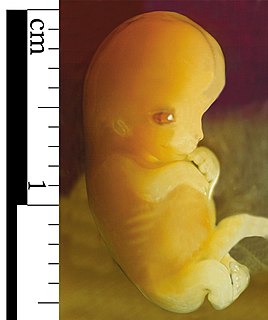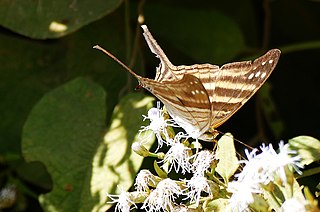
An embryo is an early stage of development of a multicellular organism. In general, in organisms that reproduce sexually, embryonic development refers to the portion of the life cycle that begins just after fertilization and continues through the formation of body structures, such as tissues and organs. Each embryo starts development as a zygote, a single cell resulting from the fusion of gametes. In the first stages of embryonic development, a single-celled zygote undergoes many rapid cell divisions, called cleavage, to form a blastula, which looks similar to a ball of cells. Next, the cells in a blastula-stage embryo start rearranging themselves into layers in a process called gastrulation. These layers will each give rise to different parts of the developing multicellular organism, such as the nervous system, connective tissue, and organs.

Convolvulaceae, known commonly as the bindweed or morning glory family, is a family of about 60 genera and more than 1,650 species of mostly herbaceous vines, but also trees, shrubs and herbs, and also including the sweet potato and a few other food tubers.

Tilapia is the common name for nearly a hundred species of cichlid fish from the coelotilapine, coptodonine, heterotilapine, oreochromine, pelmatolapiine and tilapiine tribes, with the economically most important species placed in Coptodonini and Oreochromini. Tilapia are mainly freshwater fish inhabiting shallow streams, ponds, rivers, and lakes, and less commonly found living in brackish water. Historically, they have been of major importance in artisanal fishing in Africa, and they are of increasing importance in aquaculture and aquaponics. Tilapia can become a problematic invasive species in new warm-water habitats such as Australia, whether deliberately or accidentally introduced, but generally not in temperate climates due to their inability to survive in cold water.

Philydor is a genus of foliage-gleaners, birds in the ovenbird family Furnariidae. It contains the following species:

The chestnut-winged foliage-gleaner is a species of bird in the Furnariidae family. It is found in Bolivia, Brazil, Colombia, Ecuador, Peru, and Venezuela. Its natural habitat is subtropical or tropical moist lowland forests.

Stachyris is a genus of passerine birds in the Timaliidae family.
The chestnut-winged babbler is a babbler species in the family Timaliidae. It occurs in the Malay Peninsula from southern Thailand to Singapore, and in Sumatra. It inhabits forests and shrublands up to 800 m (2,600 ft) altitude. It is listed as Least Concern on the IUCN Red List.
Monotomidae is a family of beetles in the suborder Polyphaga, containing the following genera:
Bactridium is a genus of root-eating beetles in the family Monotomidae. There are about 18 described species in Bactridium.

Dorcadion fulvum is a species of beetle in the family Cerambycidae. It was described by Scopoli in 1763, originally under the genus Cerambyx. It is known from Austria, Bosnia and Herzegovina, Romania, Moldova, the Czech Republic, Hungary, North Macedonia, Bulgaria, Poland, Albania, Slovakia, Croatia, Slovenia, Serbia, and Ukraine.

Monotominae is a subfamily of root-eating beetles in the family Monotomidae. There are about 10 genera and more than 80 described species in Monotominae.

Lycaena editha, known generally as the Edith's copper or great gray copper, is a species of copper in the butterfly family Lycaenidae. It is found in North America.

Proteides mercurius, the mercurial skipper, is a species of dicot skipper in the butterfly family Hesperiidae. It is found in the Caribbean Sea, Central America, North America, and South America.

Marpesia chiron, the many-banded daggerwing, is a species of daggerwings, map butterflies in the family Nymphalidae. It is found in Central America, North America, and South America.

Stilobezzia is a genus of predaceous midges in the family Ceratopogonidae. There are more than 330 described species in Stilobezzia.
Bactridium striolatum is a species of root-eating beetle in the family Monotomidae. It is found in North America.
Bactridium obscurum is a species of root-eating beetle in the family Monotomidae. It is found in North America.

Electrostrymon angelia, the fulvous hairstreak, is a species of hairstreak in the butterfly family Lycaenidae. It is found in North America.

Ceroplastes is a genus of wax scales in the family Coccidae. There are more than 130 described species in Ceroplastes.
Bactridium ephippigerum is a species of root-eating beetle in the family Monotomidae. It is found in North America.













